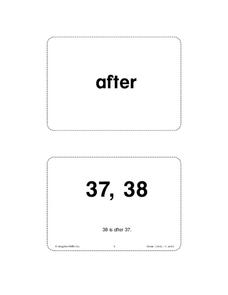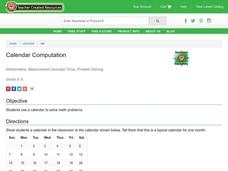Concord Consortium
Leap Years and Calendars
How many birthdays do leap year babies have in a lifetime? Learners explore the question among others in a lesson focused on different calendar systems. Given explanations of the Julian, Gregorian, and Martian calendars, individuals use...
CK-12 Foundation
Common Multiples: Sports Calendar
Using a calendar, basketballs, and tennis balls, young mathematicians determine the common multiples of four and six. Individuals drag and drop the balls onto the correct dates each sport will be played, allowing them to see which days...
Houghton Mifflin Harcourt
Unit 5 Math Vocabulary Cards (Grade 1)
Boost math vocabulary instruction with a set of 16 flashcards. The cards highlight math terms with bold typing, and represent each word using a labeled picture. Topics include measurement-related terms like calendar,...
Math Learning Center
Third Grade Assessments and Scoring Checklists, Common Core State Standards
How are your learners doing with place value? Track their skill levels with a set of math assessments. The packet includes worksheets to hand out to your class, scoring checklists, a calendar for implementation, and instructions for...
Math Learning Center
Second Grade Assessments and Scoring Checklists, Common Core State Standards
How are your second graders progressing in their math skills? Find out with a series of math assessment activities. With baseline assessment score sheets for each skill, you can track how well your kids are adding, subtracting, telling...
Public Schools of North Carolina
Math Stars: A Problem-Solving Newsletter Grade 2
Develop the problem solving skills of your young learners with this collection of math newsletters. Covering a variety of topics ranging from simple arithmetic and number sense to symmetry and graphing, these...
Public Schools of North Carolina
Math Stars: A Problem-Solving Newsletter Grade 1
Keep the skills of your young mathematicians up-to-date with this series of newsletter worksheets. Offering a wide array of basic arithmetic, geometry, and problem solving exercises, this resource is a great way to develop the...
Curated OER
Reading a Calendar
Calendars are great for so many reasons. They keep track of time, can help teach children to read charts, show numbers in sequential order, and are perfect for word problems. First graders assess three different calendars to answer 11...
Curated OER
Calendar Year Worksheet
How many days are in a leap year? Years in a century? Get your mathematicians applying their skills to everyday life with this calendar math instructional activity. Ten questions prompt students to think about various time increments....
Curated OER
An Extra Day!
Leap year is an important concept to understand- give learners some practice with this complete-the-calendar activity. The calendar month of February during a leap year is pictured, however it is incomplete. Scholars complete the month...
Curated OER
Calendar Computation
Students solve math problems by using a calendar. In this problem solving lesson, students review the days of the week and months in a year. Students complete a problem solving worksheet about the calendar.
Curated OER
Use a Calendar English Learners 16.6
For this calendar worksheet, students analyze a same calendar page. Students answer 5 multiple choice questions about the calendar. This page reinforces the difference in: date, week, month, year.
Curated OER
Use a Calendar Practice 16.6
In this calendar instructional activity, students solve 6 problems using the information on twelve calendar pages. Students fill in the answers.
Curated OER
Use a Calendar: Homework 16.6
In this calendar worksheet, students analyze a sample calendar page and use this to answer 6 questions. Students locate the specified dates and days of the week.
Curated OER
A Month of Summer: Enrichment 16.6
In this calendar math worksheet, learners use the information on a sample calendar page to answer five questions. Students find the specific dates or days to solve the problems.
Curated OER
Use a Calendar
In this calendar learning exercise, students use a sample calendar to answer 9 questions. Students name months and days before and after specific dates given.
Curated OER
Days of the Week - September 2009 Calendar
In this calendar worksheet, 2nd graders examine a calendar of September 2009. They determine how many Sundays, Thursdays, Mondays, and Fridays there are. They write the numbers on the 4 blank lines.
Curated OER
Days, Month, Year - Calendar Practice
For this calendar math practice worksheet, 2nd graders answer 6 multiple choice questions about days, months, and the year. They answer questions such as "What is the fifth month of the year?" and "How many days does September have?"
Curated OER
Year 6 Time Booster pg. 4
The month of February is the focus of this calendar worksheet. Students must look at the calendar and answer 4 word problems about the month of February. Interestingly, this particular February happens to be a leap year with 29 days!
Curated OER
Math With Calendars
In this math worksheet, students examine a single calendar page and answer 10 questions using the information that is displayed.
Curated OER
Calendar Math
Students count and name the numbers and days on the calendar in order to determine the date. They identify the month and the entire date, and determine the pattern shown on the calendar markers. Students then calculate how many days...
Curated OER
30 Days Hath September
Fourth graders memorize the poem, Thirty Days Hath September in preparing for learning about the number of days in the months and year. Once memorized, they practice using the calendar to count the number of days in different problems.
Curated OER
Calendar Questions
In this calendar math worksheet, students use a calendar to complete the counting questions about specific days in the months. Students also write dates in long form and short form.
Rice University
Rice University: Cynthia Lanius: Algebra Fun With Calendars
A fun algebraic problem involving a calendar. Discussion, solution, and follow-up problem are included.

























